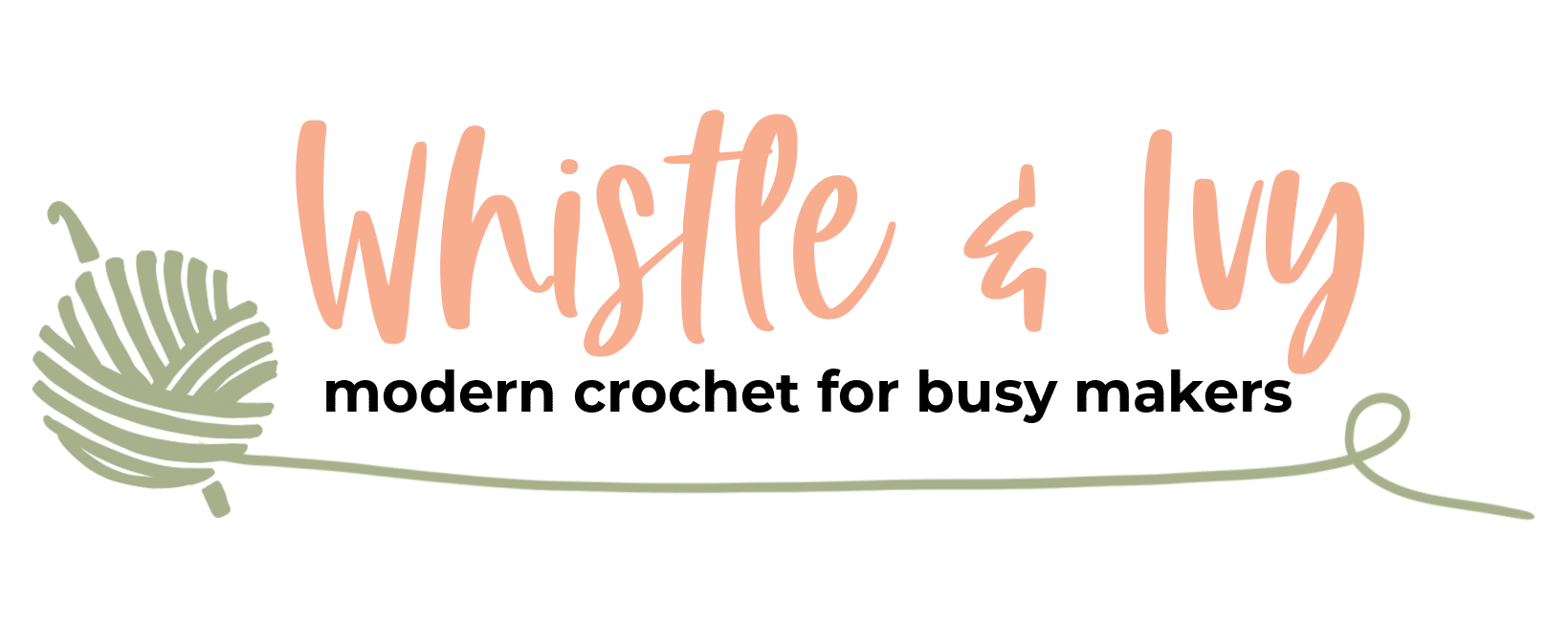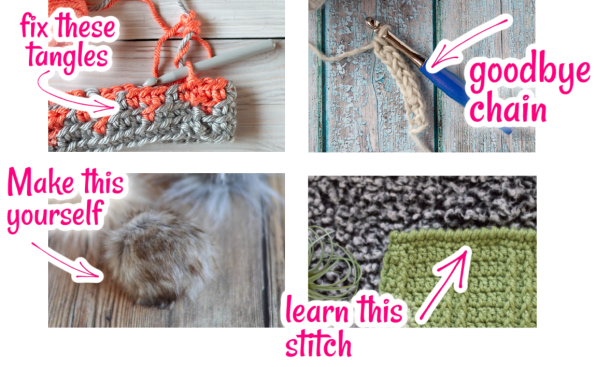You guys.
It’s happening. I am finally taking the leap. I am going to learn how to knit.
I put it out there on social media a couple weeks ago, which is helpful when setting goals. But I really wanted to be as ready as possible. I asked those of you who knit if you had any advice for a crocheter learning to knit.
I am SO GLAD I asked. So much gold in your responses. Thank you!
So for anyone else who may be motivated to learn as well, I hope you join along with me!

So without further ado, here are some awesome tips for a crocheter learning to knit:
1. “Be patient and always know you can do it” – Nora
2. “Keep a hook handy for dropped stitches. Use a lifeline (scrap yarn that you thread through your stitches) on lace projects so it”s not so traumatic if you have to rip your work back. Block your swatches, it really helps.” -Miranda
3. “Just have fun and don’t be afraid of making mistakes. It all washes out in the end.” Blanche
4. “Be very, very patient.” – anonymous
5. “It was very difficult to learn for me, but just keep going, you WILL get it. And when you feel like throwing the needles and yarn against the wall – go ahead, take a deep breath, pick them up and keep going!!!” – Cheryl
6. “Take your time and start small. Dishcloths are a great option. You can try out lots of different patterns and if they don’t turn out square, it’s okay because they’re dishcloths!! Have fun with it.” – Pat
7. “Patience…it takes longer to knit something than to crochet.” – Alison
8. “Learn the European or Continental way-the yarn is used in the left hand like crochet so I think it would be easier for a beginner knitter to learn.” – Patti
9. “Patients and learning the two basic stitches you will be able to accomplish almost every pattern.”
– Rondel
10. “Be patient with yourself and go slow (knitting is slower than crocheting). Practice every day to get comfortable with the process. I learned to crochet 30 years ago and learned to knit 3 years ago. When I first learned to knit I kept thinking that I was never going to get it and almost quit several times in the first few weeks. However I kept knitting every day and after about 3 weeks I realized that I was starting to feel comfortable with the knitting process and since then I’ve made many things including beautiful lace scarves that I never thought I could make.” -Deborah
11. Since you already crochet, many find knitting the continental way easier. There are plenty of YouTube videos that show you how to knit, purl and lots more! KnitPIcks.com has some good tutorials also. I would start with larger needles and make a dishcloth or a scarf. You will do great! I taught myself to knit when I was younger and am confident you can too. Also, your knitting friends/family or local yarn shop will have people who are more than happy to teach you. – Mary
12. “Practice learning the basics for a while til you get it down.” – Sherry
13. Just keep trying. It will get easier. – Sharon
14. I am still a beginner but using a chunky yarn and big needles really helped me. Also, check out continental knitting. You hold the working yarn in your left hand instead of your right. It was a lifesaver, I could not for the life of me get used to holding the yarn in my right hand. – Heather

I SEE YOU, BUSY MAKER
You’re tired of sifting through complicated tutorials and daunting patterns that leave you feeling overwhelmed.
Let me help.
Picture this:
🧶 Joining a thriving community of fellow crocheters who share your passion.
📚 Access to our ENTIRE library of patterns that will buildsyour confidence.
🎁 Gifting handcrafted treasures to be cherished by your loved ones.
🌟 Modern, easy-to-follow patterns that will leave you feeling accomplished.
It’s time to make your crafting experience as joyful as it should be. We can’t wait to meet you!
15. “Here is a rhyme that I used to teach a group of kids knitting. In thru the front door, yarn around the back, out through the front door and off jumps jack. I know this is a bit silly, but it helps you to remember how to go in the stitch, wrap the yarn and come out of the stitch.” – Michelle
16. “You can learn at any age. I was 44 when I learned and haven’t stopped! Good luck.” -Patricia
17. “Try continental style knitting, so much easier for me after 25 years of crocheting. Also check out local classes, I found we had one for $10 which taught me to do the basics.” – Karla
18. “Be patient. We didn’t learn to crochet overnight, so don’t expect the same with knitting. One of the first thing you read about is what to do if you drop a stitch because it WILL happen. Be prepared so you know how to handle when it does.” -Kathy
19. “Youtube is your best friend for learning new stitches that you are unsure of.” – Fiona
20. “I learned to knit first, so my perspective is different, but I think it helps for you to think of knitting as crochet with 2 needles, like I had to envision crochet as knitting with one needle. I strongly recommend beginning with circular needles because it is easier to keep the yarn from slipping off the needles.” – Susan
21. “First thing is don’t expect it to go as fast as crocheting. I prefer to think of knitting as driving a comfortable old car and crocheting like driving a sports car. i love to knit because i like to “enjoy the ride.” You can see things take shape and its relaxing. Take it slow and try not to get frustrated. Pick your yarn, pattern and get started. Remember we all make mistakes, just keep at it. your patience will pay off.”
– Kathryn
22. “I would suggest that they learn on circular needles. They are not as awkward as strait needles.”
– Christine
23. “Read the pattern before you start, and look up knitting stitches before hand, if unsure… :)”
– Anonymous
24. “I learned how to knit American style at age 8, crochet at 13, and as an adult, I decide to teach myself Continental knitting as holding the working yarn in my left hand, as in crochet, felt right! ☺” – Sue
25. “Take it slow master each stitch before going to the next – the key is to learn what all the little details look like so you know when you make an error and then learn how to correct it before you get much farther with your work.” – Jeanie
26. “I wish I had learned to knit Continental style first. I think that as a crocheter I would have found it easier to hold the yarn in my left hand when I learned to knit. Unfortunately when I first started knitting, I didn’t know that was an option. I have recently made the switch and it was almost like learning all over again, but it was worth the effort. I enjoy knitting a lot more now that I’m on ‘team Continental.'” -Maria
27. Start with something simple with plain yarn and at least 8.5 needle; so that you can see your stitches easily. Don’t try to start with fancy yarns or small needles. Scarves are a good starting project. Also, start with simple stitches until you get the knack of working with two needles instead of one hook. Good luck.
– Lois
28. “Something I found helpful was to find the knitting needles that worked best for me. There are so many out there, aluminum, plastic, bamboo and so many others. For the most part I prefer bamboo. He works will slide easily but will stay in place when it needs to.” – Hajni
29. “Check all stitches and take your time with every stiches when you are knitting.” – Sandra
30. “Never be afraid to try a new stitch or a new pattern. It will only make you a better crafter.” – Debbie
31. “Find someone who knows what they are doing!! It’s So difficult to learn on your own!” – Anonymous
32. “I have been a Continental Knitter for 47 years. I learned crochet first then when I wanted to jump into knitting it just made sense to me to wrap my yarn on the left index finger. This knitting technique is easy to learn & your work goes very quick. I also suggest you start out learning using size US 8 knitting needles (what ever type of needle you want to use bamboo, metal/aluminum, or plastic. it’s just preference) & Worsted weight Yarn (4) because of the texture & weight of the needles & yarn help you get the feel of the knitting. I teach kids to adult & this is what I use to teach with. You can find great YouTube Videos to assist you. If you are a crocheter I highly recommend this method. You already have the know how to hold your yarn. It’s just a matter of getting the hang of holding on to 2 needles instead of 1 Hook. Keep practicing & don’t give up. Things will fall into place! I always have my students practice with making squares first then they have the confidence to make larger projects. I am an e-mail away if any one needs help as I love to teach. You can also find me on Facebook Handmade KNITS by CHRIS www.facebook.com/groups/434283770057690/ Happy Knitting!” – Christine
33. “My friends grandma taught me how yo crochet and knit! Learn how to knit a line the purl a line, once you can do this you can do any pattern, just as with crochet it all about tension and neatness. Don’t be overwhelmed just go with it! It’s easy. You will get the hang of it. I have many knitting friends who shudder at the thought of doing crochet, practice practice practice xx” – Pauline
35. “Two predictions: You’re going to love knitting, you’ll be great at it and it will come quickly & easily to you! Ok, that’s 3 predictions! I was in the same boat! I learned to crochet as a child. Have loved crocheting for (gasp) 40 years! But I wanted to knit too! You already know about yarn, patterns (in general), charts, gauge, tension, stitch markers, stitching top down, bottom up & in rounds. Yes, holding & manipulating the needles will feel awkward at first, but you’ll have a head start, because you’ll intuitively know how to hold the yarn to “throw it”. You’ll get comfier the more you just do it! I recommend starting with bamboo needles & cotton yarn. I remember one of my biggest initial anxieties was all those stitches slipping off the slick needles! Bamboo & cotton have more “bite” on the needle, helping minimize that fear. :). I also recommend small projects to start, that way you can try out lots of new stitch patterns (although, remember, there’s only 2 stitches! Knitting & purling! So don’t feel overwhelmed!)…you can practice changing colors and you’ll enjoy that immediate gratification. I often use swatches as coasters all over my house & offices. :). If you learn to knit making wash cloths, dish cloths, potholders, coasters & tiny snack placemats…you’ll have something useful to show for your efforts & nothing makes a prettier gift for housewarming, wedding shower, baby shower, etc than a pretty stack of handmade cloths tied with beautiful ribbon. :). Another big suggestion…if you’re at all like me, you’ll learn quicker & easier if you have someone teach you in person. I highly recommend a class at your local yarn shoppe. That way you not only get an experienced teacher, you usually get a class full of supportive new friends too. :) When not in a class, YouTube videos are very helpful. Love Purl Soho’s tutorials. Great site overall. Beautiful patterns! Oh! And you love baby items! You’ll be knitting booties in no time flat! And hats, mittens, sweaters, blankets, toys, you name it! Debbie Bliss has wonderful baby knitting patterns! My fave part is knitting something & crocheting a border or edging around it! So cool to know how to do both! Relax, enjoy & be patient with yourself. You’re going to love knitting!” – Lynne
36. “I crocheted for 15 years before I ever picked up a knitting needle. Casting on was the hardest part for me at the beginning. I usually let a friend cast on for me, then she’d knit the first row. After that, I just knitted along! I didn’t learn to purl until a few years later, so just stick to one stitch at a time. also, if you need to put your work down, don’t do it in the middle of the row. You’ll never know which way you were going, and you will end up switching it around. I made dish towels and baby blankets for a long time, and they were never square because I couldn’t figure out which way to go when I came back in the middle of the row. Also, start with something small, only 20-30 stitches wide, don’t try to start anything big your first time. I prefer wooden needles, because they’re less slick, and the yarn has less of a tendency to fall off when it’s not supposed to. Don’t worry about buying expensive needles at first though. I got a wooden dowel rod from the hardware store for less than a dollar. (It was about the width of a pencil) and broke it in half. I’m sure you could cut it if you have a saw or a sharp knife. I didn’t. Then I just put it in a pencil sharpener to sharpen 1 end of each rod. Then just wrapped a rubber band around the opposite end. Until I got better a knitting, this is what I did. It was about the right size for Red Heart Super Saver yarn. You can also use chopsticks as knitting needles. When going from Crochet to Knit, you must know that in general, knitting takes longer, but it uses less yarn. Crochet is quicker, but uses more yarn (about 1.5 times the amount). I find Knitting is easier to teach and easier to do, but I still prefer Crochet. it seems more versatile and quicker. It’s very difficult in knit to make round things such has hats or socks, or even things like granny squares that start in the middle of the motif. It is possible, but I’ve never figured it out. I’ve been knitting for about 5 years now. I usually use knitting for things like scarves, shawls, wraps, or wash cloths. (Flat shapes, with straight sides). Also, don’t worr,y if you can’t get it right away. it takes time. If you need to, get a knitting loom. You can make things that look similar, and they’re much easier to do! Knitting looms also help you understand what each loop is doing and the difference between purls and knits, and casting off and on. you can also very easily do hats, scarves, and mittens with the looms!)” – Tiffany
37. “Well you do not have to loop all the wool round your hand, just around the forefinger helps, just push the right needle into the stitch on the left side and of course dont drop the sticth, just transfer it to the right needle and off you go.” Julia
38. “I started out crocheting at age 9, learning how to do granny squares first and then moving on to other stitches. I didn’t start knitting until I was in my teens. Knitting took me quite a bit longer to learn because no one wanted to teach a left hander how to do it, but as a fiber craft it’s not really all that different than crochet, you just have more tools to use at one time. The hardest thing I found when learning how to knit was how to tension the yarn differently than when crocheting. Once you get that down, the rest is just a matter of learning how to do knits and purls for the most part. The best piece of advise I leaned along the way was to put in lifelines for more complex patterns. They really save the day when you get into lace and cable patterns. I’ve been knitting for more than 30 years now and I still use lifelines on really intricate patterns.” – Marcia
39. “Never give up, disregard negative critism and carry on, you will succeed.” – Cathy
40. “Use a similar wind on your fingers as you do when crocheting to get the tension consistent while knitting.” – Oriel
41. “Definitely have a look at the Portuguese knitting style; it uses minimum hand movement, making it not only quicker than other knitting styles (something I personally, as a crocheter love!), but more importantly easier on the the hands!” -Caro
42. “Start with something small, a hat or a scarf or cowl. It will not be as daunting as a large project until you get the hang of it. MOST IMPORTANT ADVICE ~ There is no such thing as a stupid question. Keep asking questions. Keep practicing.” – Joan
43. “Remember you have 2 needles, one in each hand, you will need room to work if you take your work travelling bus, train. when I work a long or heavy project it helps to an extra long needle (correct size) and a normal length, the longer one can be tucked under your arm, helping to take the extra weight off your wrists. same time back I used this way of knitting because I had trouble with my right, arm knitting was the only craft I could do at the time. it saved many a day of frustration not being able crochet, saw or much else in the way of craft.” – Jackie
44. “Use light needles with a little bit of grab to them, nothing too slick! It helps with tension and uniformity of stitches, as well as keeping dropped stitches to a minimum! ” – Vickie
45. “Take your time because, when you rush you make mistakes :):” – Sharon
46. “Knitting is easier, fewer “rules”. eyelash yarn and other “hairy yarn hide a multitude of errors. makes for a good first project scarf.” Arlene
47. “I learned to knit a few years ago and I wished there was a guide specifically for crocheters learning to knit. I wrote up some things on my own little blog after a while. Here’s the link for a more in depth explaination of some of these things: https://theunknownorchard.blogspot.com/2016/01/learning-to-knit-if-you-already-know.html Here’s the jist: A video is worth a million words. Look up an abbreviation guide. Learn about the different types of needles (I much prefer circular, interchangeable needles to anything else), and the different materials they are made out of. Knitting can cost more than crochet in terms of tools and ‘nicer’ yarn. (Also – knitters can be seen as ‘snobbish’ because of this and some knitters look down on crochet! Craft drama!!!) Obviously, get a ravelry account (you probably already have one for crochet, but this needs to be said!). Placing a stitch marker is much different – in crochet, you mark the yarn stitch, but in knitting you place a round marker on your needles between stitches, not on the actual yarn. Learn both methods of knitting (English vs. Continental) and don’t let anyone tell you which you should do – learn both and see what you like for different situations. Learn very early on how to pick up a ‘dropped stitch’ – it is not a big deal and it’s easy to fix – and practice making a mistake and fixing it so you don’t freak out later. Learn how to place a ‘life line’ in your knitting so that it doesn’t come unraveled. On that note, learn how to ‘read’ your knitting and figure out what loop is going through what other loop – this will vastly improve your knitting. Try tunisian crochet first – sounds like weird advice, but it’s a hybrid of knitting and crochet so it will get you used to knitting while keeping you in your comfort zone. And lastly, welcome to knitting – it is so fun! If you get frustrated, don’t give up, just put it down and come back later. Practice, practice, practice!!” – Pamela
48. “Use two colors of needles at first, it helps to keep things straight.” – Deanna
49. “I’ve been crocheting since I was a kid and taught myself to knit about 2 years ago. I used a “how to” book and knittinghelp.com. knitting help has a bunch of super helpful videos. Learning to knit seems intimidating but isn’t as difficult as we make ourselves think it is. ” – Anonymous
50. “My best advice for beginning knitters is to use bamboo needles. They are not as slick as metal or plastic needles and your needles aren’t as likely to slide out of your knitting, especially if you decide to try to knit socks on 3-4 double pointed needles.” – Cecelia
51. “There are many different ways to knit so research the way you think would suit you best. Once you begin, choose your pattern carefully. Some are not well written. Patterns are like recipes & I have heard them called this several times. Good patterns clearly list the ‘ingredients’ needed and let you know what will happen if you don’t use the same ‘ingredients’ as those used in the original. Otherwise, you find out the hard way! Therefore, make sure you understand ALL the instructions given in a pattern, and do become familiar with abbreviations used. Good patterns also explain the abbreviations. Join a good facebook group. I can recommend one. ;)” – Anonymous
52. “I learned to crochet first, at age 9. Knitting came along much easier because I was already aware of tension, knew how to hold the yarn, etc. . That said, I wish I had known: how to “tink,” (knit backwards), use a “lifeline” when having to “frog” (rip-it out), been more realistic about a 1st project (I made a fair isle sweater), known to use a well “twisted,” smooth yarn as a new knitter, known to cast on and bind off loosely. Be intrepid! It’s only sticks and string! All new skills improve with practice!” – C. A.




I learned to knit (garter stitch) when I was in the 7th grade. In school and we all made a poodle that fit over a wine bottle. Our home room teacher, I think. Even the boys! I have tried over the years, occasionally, to knit, but crochet is my strong suit. I recently have started to try knitting again and made a scarf, hat and horrible-looking sweater. I am working on a baby blanket now that I have pretty much taught myself to follow a pattern. I bet I unraveled that thing at least 50 times and started over because of mistakes. I am very near done with it now and I STILL made some mistakes but they are not that bad and unless I was going to show it or something, I would be devastated. It still looks beautiful and I won’t hesitate to give it as a gift.
Great advise, Thank you!! I am a crocheter that is trying to learn to knit. I wish I had read these tips before I started as I am having a hard time. I can tell you DON”T try to learn by making mittens, it was a complete fail and I almost gave up. Now I will try again this weekend with a simple cowl and watch the You Tube videos on continental knitting first of course.
Thanks again !!!!
I’ve been crocheting most of my life and am on my second attempt to learn to knit also. My first attempt began as I was approaching 40 and felt like I needed something new in my life. I made a couple of skinny scarves, a pair of mittens and a beanie. Then I put it down for a few years. Now that I picked it up again, I find there are a lot of great places to find help in the internet. Verypink.com is a great place for tutorials. I credit Staci with my newfound interest. I began by making lots and lots of dishcloths from her patterns. Then I moved on to a scarf and a beanie that is knit flat and then seamed up the back (from a yarn skein label). I am also making a Ten Stitch Blanket from Ravelry that is great practice. Staci has a tutorial on that as well. Just knitting ten stitches at a time in a big square spiral whatever size you want. Mine is for my king sized bed, so I will have lots of practice. I have now created my first sock EVER (Staci’s bulky sleep socks) and am almost done with the second. It is so much fun!
To tell the truth, I considered knitters to be snobs looking down on crocheters like the lady’s comment above and I was sort of snobbish for crochet over knitting because of that. Now, after discovering all the knitting podcasters that love crafting so much, they seem to be much more normal. They just want to create things like I do.
I’m so glad I took the leap and I think you will be fantastic at it!
I love your crochet patterns. I have only discovered your site in the last few weeks, but they look amazing! Welcome to the club of knitting crocheters!
These are all really good. I started crocheting at 2 or 3 and have been trying to learn to knit since I was 13. I’m now 32 and i’m still trying. For a while there I thought I’d finally got the hang of it, only to learn that I was not knitting or purling but making stitches somewhere in between that do not have names! lol So I guess the advice I would add is, make sure you have a way of telling if you’re doing it right or not! Whether it’s a youtube video (boy, I am so grateful for Youtube! Wish they’d had that all these years…sigh) or a really good book with lots of detailed pictures (make sure they haven’t been accidentally flipped! that has caused me worlds of problems), or someone who actually knows how to knit who can help, have a good reference. Without one, sometimes you can be sure you’re doing everything wrong and frog it only to find out that you had it right after all!
Hi Bethany. I’m in exactly the same position. I’m a crocheter who’d love to learn to knit. Great tips, especially no.7. My main problem with knitting is patience. It seems so slow compared to crochet. Good luck :)
Thank you! You too!
I’m sort of in the reversed position. I learned how to knit in school about 20 years ago but have only recently decided to learn ti crochet. I have been using your youtube videos to make the Bitty Bow Baby sandals for my niece (one done, one to go) and I have to thank you because I can actually do it following your video. But I keep holding on to the yarn too hard. That is my biggest problem with crochet… Until yesterday, when I decided to begin on a scarf. I learned your way, American vocabulary, and was doing fine with that. This is a Dutch pattern. And I am not Dutch :-p (Swedish living in the Flemish region of Belgium) And every stitch has a different name. It feels so backwards! I’m so lucky the pattern included drawings :-)
Lots of great advice, now I am ready to learn to knit (whenever you are)!
Yay!!